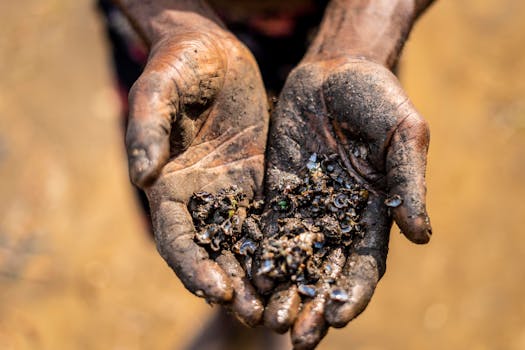
**
Modi's Africa Gambit: Rare Earth Minerals, Geopolitical Strategy, and the Fight Against Resource Weaponization
Prime Minister Narendra Modi's recent diplomatic forays into Africa signal a significant shift in India's foreign policy, focusing heavily on securing access to critical minerals, particularly rare earth elements (REEs). This strategic move, while aimed at bolstering India's technological independence and economic growth, also underscores a growing global concern: the weaponization of critical minerals and the need for a fairer, more equitable distribution of these vital resources. The push for REE access in Africa is not just an economic play; it's a complex geopolitical maneuver with implications for global power dynamics and resource security.
The Allure of African Rare Earths
Africa possesses vast untapped reserves of rare earth elements, crucial components in manufacturing high-tech products like smartphones, electric vehicles, wind turbines, and military hardware. This abundance makes the continent a key player in the burgeoning global REE market, a market currently dominated by China. India, heavily reliant on imports for its REE needs, is actively seeking to diversify its supply chains and reduce its dependence on a single source. This pursuit aligns perfectly with Modi's vision of "Atmanirbhar Bharat" (Self-Reliant India), a policy prioritizing domestic manufacturing and technological self-sufficiency.
Several African nations, including South Africa, Namibia, and Madagascar, are rich in REEs, but lack the technological expertise and investment needed for efficient extraction and processing. This creates opportunities for collaborations between India and African countries, where Indian expertise and investment can be leveraged to unlock Africa's mineral potential, benefitting both parties. This mutually beneficial approach stands in stark contrast to the historical patterns of resource extraction that often left host nations impoverished.
India's Strategic Partnerships in Africa: Beyond Economic Gain
India's engagement with Africa extends beyond mere economic interests. The strengthening of ties with African nations aligns with India's broader geopolitical strategy, aimed at countering China's growing influence in the region. China's Belt and Road Initiative (BRI) has significantly increased its presence in Africa, securing access to vital resources and infrastructure projects. India's engagement, therefore, represents a counterweight, offering an alternative partnership model based on mutual respect and cooperation rather than dominance.
This strategy encompasses:
- Investment in infrastructure: India is investing in developing infrastructure in African nations, improving connectivity and facilitating resource extraction and trade.
- Technology transfer: India is sharing its technological expertise in mining, processing, and refining rare earth minerals.
- Capacity building: India is providing training and educational opportunities to African professionals in the mining and related sectors.
- Development assistance: India is providing developmental aid and supporting projects that promote sustainable development and poverty reduction.
The Weaponization of Critical Minerals: A Growing Concern
The growing importance of rare earth elements has sparked concerns about the potential weaponization of these resources. Countries with significant REE reserves could use their control over supply chains to exert political and economic leverage over other nations. This threat is particularly acute in times of geopolitical instability or international conflict. Restricting the supply of REEs could cripple a nation's technological capabilities and economic output. This is why diversification of supply chains and fostering international cooperation are crucial.
The use of critical minerals as geopolitical leverage is not a hypothetical concern. We've seen hints of this in the past, with disruptions in global supply chains affecting the production of various goods. This scenario highlights the need for international cooperation to establish transparent and equitable norms governing the extraction, processing, and trade of critical minerals.
Countering Resource Weaponization: A Collaborative Approach
The challenge of preventing the weaponization of critical minerals requires a multi-pronged approach:
- Diversification of supply chains: Nations must diversify their sources of critical minerals to reduce dependence on any single supplier.
- Investment in domestic processing: Investing in domestic processing capabilities reduces reliance on foreign processing facilities and increases security of supply.
- International cooperation: International cooperation is essential to establish fair and transparent governance frameworks for the extraction and trade of critical minerals. This includes promoting responsible sourcing and preventing illicit activities.
- Sustainable mining practices: Environmental sustainability is crucial. Mining operations should adhere to strict environmental regulations to minimize their impact on local communities and ecosystems.
- Technological innovation: Investing in research and development to discover alternatives to rare earth elements or develop more efficient methods for their extraction and recycling is essential.
Conclusion: A Balancing Act
Prime Minister Modi's push for rare earth minerals in Africa represents a significant geopolitical and economic strategy for India. While the pursuit of these vital resources is understandable given their critical role in modern technology, it is essential to approach this endeavour responsibly and collaboratively. The international community must work together to prevent the weaponization of critical minerals and establish a framework that ensures fair and equitable access to these resources for all nations. The success of India's Africa initiative will depend on its ability to balance economic interests with ethical considerations and foster strong, mutually beneficial partnerships with African nations. Only through collaborative efforts can we navigate the complex landscape of critical minerals and mitigate the potential for conflict and resource scarcity.




















